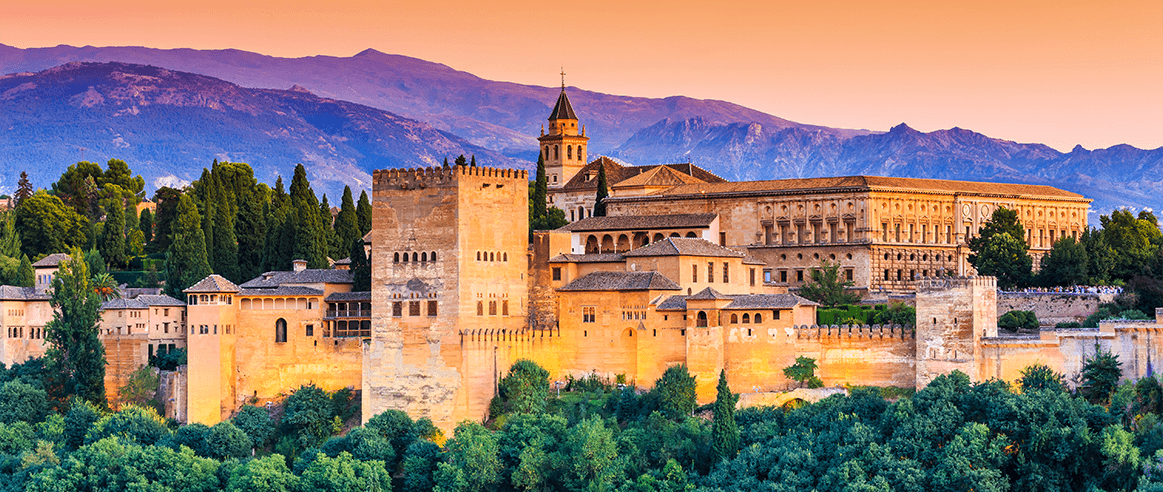Written by Jaden Parker
Alhambra in Granada, Spain is an architectural phenomenon. Made from only three raw materials—clay, lime, and aggregate of rocks and mud—Alhambra is a complex of palaces and courtyards inside a fortress called Alcazaba. The formwork and ceilings are made of wood, while gypsum and plaster cover the mud and clay walls. All the arches are made from marble.
The name “Alhambra” possibly comes from the Arabic for castle of red, Qal’at al-Hamra. Alhambra combines Moorish Islamic, Christian, and Roman architecture styles due to it changing hands throughout history. Throughout the site, Alhambra has clerestory windows, which are a series of small windows, or one long window, positioned along the top of a wall. These windows are lined with an Islamic window screen called a Mashrabiya, and its lattice is made up of geometric shapes and calligraphy from the Quran.
Mohammad I was the first person to live in Alhambra. He started working on it in 1238. In 1333, the Sultan of Granada Yusuf I made the fortress an official royal palace. Mohammad I was the founder of the Nasrid Dynasty, which was the last Muslim ruling family in Spain that ended in 1492. Emperor Charles V, the Christian ruler of the Holy Roman Empire, tore down part of the palaces to build his own larger home in the late 1490s. This started the cycle of construction, destruction, and abandonment of Alhambra.
Luckily, Alhambra has been reconstructed to its original form with historical accuracy by Jose Contreras, his son, and Leopoldo Torres Balbas. The original Alhambra was built as a fortress by the Zirites in the 9th century. Current-day Alhambra was built upon the multitude of ruins from previous forts. It was the Nasrites who decided to expand it into a royal residential palace. Alhambra is made up of three major sections. They are the Generalife gardens, the Alcazar (royal palaces), and the aforementioned Alcazaba.
Generalife is a villa outside of Alhambra to the east. It was built to represent the paradise described in the Quran. It was also a retreat for Islamic royalty when Alhambra got too crowded. The gardens are terraced, and there is a theater there with central and box seating. The name of the gardens comes from Jardines del Alarife, which means “Garden of the Architect.” There are a number of beautiful features in this garden, but two of the most spectacular are the Patio de la Acequia and the Escalera del Agua. The Patio de la Acequia connects the lower and upper gardens, and it contains the important irrigation system for Alhambra. The Escalera del Agua is a stairway with water channels for handrails under a canopy of laurel trees.
There are three major Nasrid palaces that have been restored since the Reconquista from 718-1492 when they were originally built. They are the Comares Palace, the Palace of the Lions, and the Partal Palace.
The Comares Palace features porticoed galleries and the Barca and Embajadores Halls. It was the official residence of the Sultan. The Court of Myrtles is here, which is one of the oldest in Alhambra. Also, the Torre de Comares in this courtyard is the tallest tower of the fort. There is a giant fish pond through the middle that is surrounded by myrtle bushes, hence its name. The Palace of the Lions features the Court of the Lions, which has the famous alabaster fountain of lions spewing water from their mouths. Many have heard the sounds of chains and moans from the spirits of the North African Abencerrages who were murdered in the Royal Hall. The blood stains in the courtyard can’t be removed. Finally, the Partal Palace is one of the oldest in Alhambra, dating back to the 1300s.
The final major section of Alhambra is its fortress. The watchtower view includes Plaza Nueva, the Albaicín, and the Sierra Nevada mountains. The Alcazaba features Puerta de las Armas, which is its lower level, whose door into Alhambra enters from the San Pedro forest. The bell tower in Torre de la Vela also includes the famous four flags of Andalusia, Grenada, Europe, and Spain.
Just looking at the photos, one can tell that Alhambra is definitely a stop to add on one’s bucket list. There are tons of things to find and see when visiting the beautiful site, and what better way to experience everything this place has to offer than by having a local guide show you the way. ALLMYNE can pair you with professional local guides who will work with you on a personalized itinerary so you can get the most out of your traveling. Make ALLMYNE all yours and turn on your notifications for when our app goes live!












